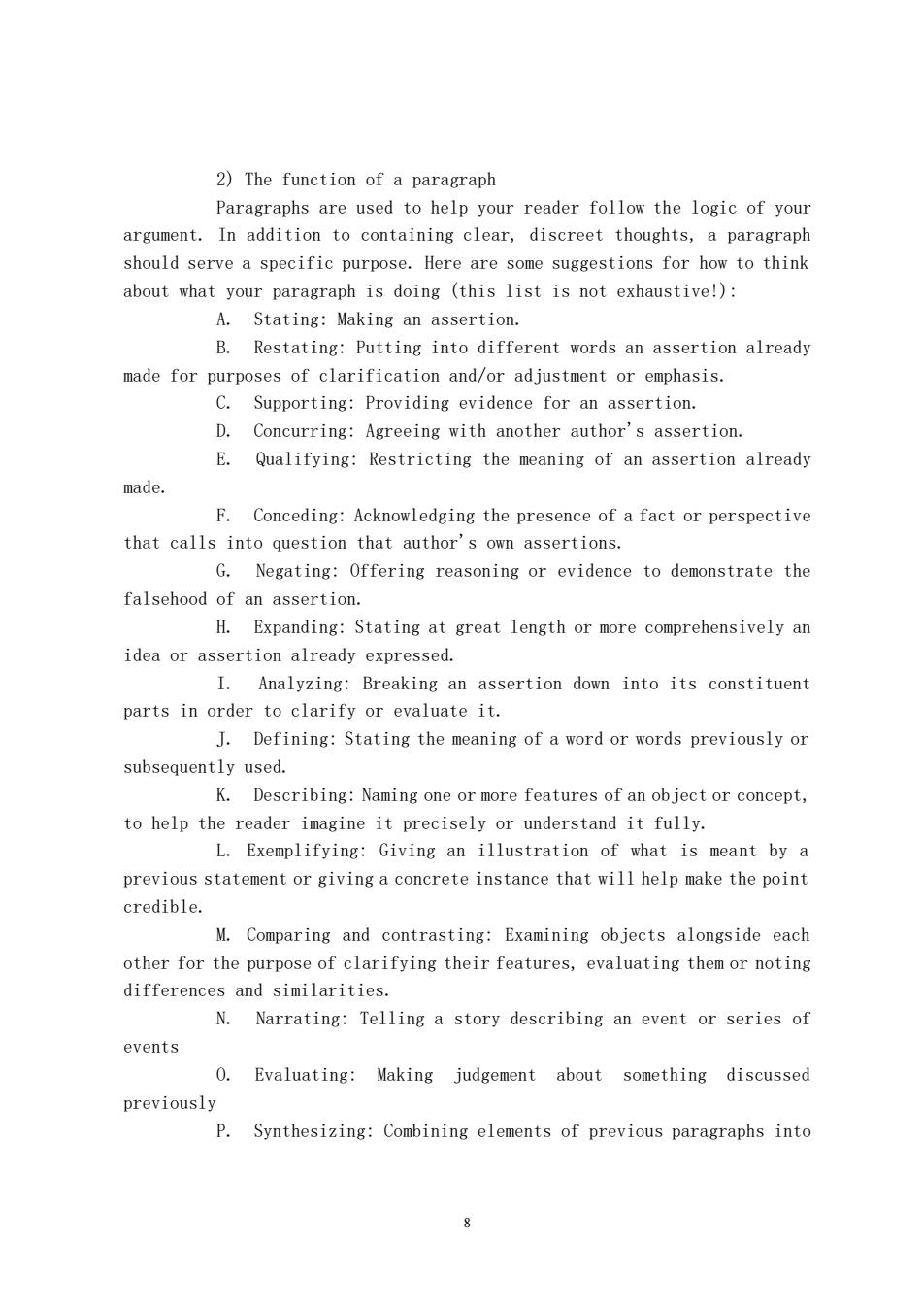正在加载图片...

2)The function of a paragraph Paragraphs are used to help your reader follow the logic of your argument.In addition to containing clear,discreet thoughts,a paragraph should serve a specific purpose.Here are some suggestions for how to think about what your paragraph is doing (this list is not exhaustive!): A.Stating:Making an assertion. B.Restating:Putting into different words an assertion already made for purposes of clarification and/or adjustment or emphasis. C.Supporting:Providing evidence for an assertion. D.Concurring:Agreeing with another author's assertion. E. Qualifying:Restricting the meaning of an assertion already made. F.Conceding:Acknowledging the presence of a fact or perspective that calls into question that author's own assertions. G. Negating:Offering reasoning or evidence to demonstrate the falsehood of an assertion. H.Expanding:Stating at great length or more comprehensively an idea or assertion already expressed. I. Analyzing:Breaking an assertion down into its constituent parts in order to clarify or evaluate it. J.Defining:Stating the meaning of a word or words previously or subsequently used. K.Describing:Naming one or more features of an object or concept, to help the reader imagine it precisely or understand it fully. L.Exemplifying:Giving an illustration of what is meant by a previous statement or giving a concrete instance that will help make the point credible. M.Comparing and contrasting:Examining objects alongside each other for the purpose of clarifying their features,evaluating them or noting differences and similarities. N.Narrating:Telling a story describing an event or series of events 0.Evaluating:Making judgement about something discussed previously P.Synthesizing:Combining elements of previous paragraphs into8 2) The function of a paragraph Paragraphs are used to help your reader follow the logic of your argument. In addition to containing clear, discreet thoughts, a paragraph should serve a specific purpose. Here are some suggestions for how to think about what your paragraph is doing (this list is not exhaustive!): A. Stating: Making an assertion. B. Restating: Putting into different words an assertion already made for purposes of clarification and/or adjustment or emphasis. C. Supporting: Providing evidence for an assertion. D. Concurring: Agreeing with another author's assertion. E. Qualifying: Restricting the meaning of an assertion already made. F. Conceding: Acknowledging the presence of a fact or perspective that calls into question that author's own assertions. G. Negating: Offering reasoning or evidence to demonstrate the falsehood of an assertion. H. Expanding: Stating at great length or more comprehensively an idea or assertion already expressed. I. Analyzing: Breaking an assertion down into its constituent parts in order to clarify or evaluate it. J. Defining: Stating the meaning of a word or words previously or subsequently used. K. Describing: Naming one or more features of an object or concept, to help the reader imagine it precisely or understand it fully. L. Exemplifying: Giving an illustration of what is meant by a previous statement or giving a concrete instance that will help make the point credible. M. Comparing and contrasting: Examining objects alongside each other for the purpose of clarifying their features, evaluating them or noting differences and similarities. N. Narrating: Telling a story describing an event or series of events O. Evaluating: Making judgement about something discussed previously P. Synthesizing: Combining elements of previous paragraphs into